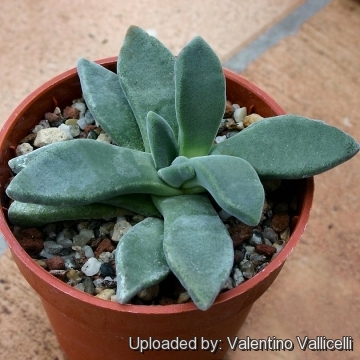Accepted Scientific Name: Deilanthe peersii (L. Bolus) N.E.Br.
Gard. Chron. 1931, Ser. III. lxxxix. 259.

Aloinopsis peersii (Deilanthe peersii) Photo by: K.k. Agrawal
Origin and Habitat: South Africa, Cape province, Free State ( Willowmore, Prince Albert)
Habitat: It growns mainly on rocky slopes, at 850-1400 m altitude.
Synonyms:
Description: Deilanthe peersiiSN|781]]SN|775]] is a low growing succulents very similar to Deilanthe thudichumiiSN|775]]SN|781]], but it flowers in the night and morning ( between 8 p.m. and 2 a.m ) while the latter flowers late in the afternoon (between 3 p.m. and 9 p.m ) reflecting that different pollinators visit the plants and also the flower morphology is different.
Habit: Forms small rosettes 2-4 cm in diameter (or more)
Leaves: Silky, pearly grey, spathulate up to 25 mm long.
Roots: Thick roots.
Flowers: Corolla orange-yellow 2,5-5 cm in diam.
Blooming season: Spring.
Bibliography: Major references and futher lectures
1) Heidrun E. K. Hartmann "Illustrated Handbook of Succulent Plants: Aizoaceae A-E" Springer, 2002.
2)Doreen Court “Succulent Flora of Southern Africa” CRC Press, 01/Jun/2000
3) Gideon Smith u.a. (Hrsg.) "Mesembs of the World: Illustrated Guide to a Remarkable Succulent Group." Briza Publications, 1998
4) James Cullen, Sabina G. Knees, H. Suzanne Cubey “The European Garden Flora Flowering Plants: A Manual for the Identification of Plants Cultivated in Europe, Both Out-of-Doors and Under Glass” Cambridge University Press, 11/ago/2011
5) Hermann Jacobsen “A handbook of succulent plants: descriptions, synonyms, and cultural details for succulents other than Cactaceae, Volume 1” Blandford Press, 1960
6) Werner Rauh “The Wonderful World of Succulents:Cultivation and Description of Selected Succulent Plants Other Than Cacti” Smithsonian Institution Press, 1984
7) Ed Storms “Growing the Mesembs” Tarrant Printing, 1976
 Aloinopsis peersii (Deilanthe peersii) Photo by: Valentino Vallicelli
Aloinopsis peersii (Deilanthe peersii) Photo by: Valentino Vallicelli Aloinopsis peersii (Deilanthe peersii) Photo by: Valentino Vallicelli
Aloinopsis peersii (Deilanthe peersii) Photo by: Valentino VallicelliCultivation and Propagation: The Delianthe persii is a "winter" grower which is most active from late winter until later spring and heading for summer dormancy, but in favourable growing conditions it keeps going over the summer too and doesn't need particular care.
Soil: Requires good drainage as it it is prone to root rot. It can grows outdoor in sunny, dry, rock crevices (protection against winter wet is required) It can also be cultivated in alpine house, in poor, drained soil.
Fertilization: It thrives in poor soils and seems sensitive to an excess of potassium.
Watering: Water minimally in summer, only when the plant starts shrivelling, water more abundantly when they are growing in the autumn and spring. Requires little water otherwise its epidermis breaks (resulting in unsightly scars).
Light: It needs a bright sunny or light shade exposure in winter, but keep cool and shaded in summer.
Hardiness: It prefer a very bright situation and will take a light frost (Hardy to -5°C) if it is in dry soil. USDA zones 9A – 11.
Uses: Container, rock garden.
Propagation: Seed in spring or cuttings. It is easily propagated by seed.












